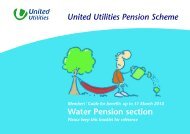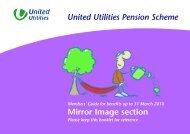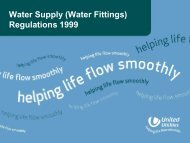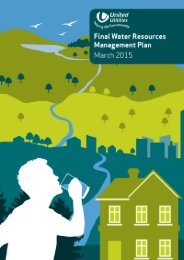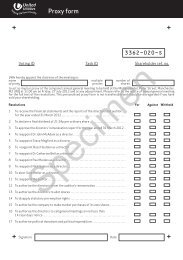Annual report and financial statement 2009 - United Utilities
Annual report and financial statement 2009 - United Utilities
Annual report and financial statement 2009 - United Utilities
Create successful ePaper yourself
Turn your PDF publications into a flip-book with our unique Google optimized e-Paper software.
BUSINESS REVIEW: PRINCIPAL RISKS AND UNCERTAINTIESPrincipal risks <strong>and</strong> uncertaintiescontinuedRISKINCREASED COMPETITION IN THE WATER ANDWASTEWATER INDUSTRYThe Cave review of competition <strong>and</strong> innovation in water marketswas published in April <strong>2009</strong>. If its recommendations areimplemented, this would eventually exp<strong>and</strong> the competitivemarket allowing retail competition to all non-householdcustomers. Ofwat has also taken steps to introduce competitioninto the water supply market through inset appointments <strong>and</strong>the water licensing supply regime. Prior to 2007 (with oneexception), inset appointees had all been granted to existingregulated companies. Since 2007, Ofwat has granted more insetappointments, two of which are within UUW’s region. Furtherinset appointments may be made in the future, resulting inincreased competition.MITIGATIONThe group has been fully engaged in the Ofwat consultationson the Cave review, although a relatively small proportion ofthe group’s profits derives directly from non-household retailactivities. If competition is exp<strong>and</strong>ed, there would beopportunities for the group to participate in a wider market inEngl<strong>and</strong> <strong>and</strong> Wales. As far as inset appointments are concerned,these generally relate to new developments or large industrialcustomers. Furthermore, the regulated business has not receivedany applications from holders of water supply licences to supplyany premises within its region.EVENTS, SERVICE INTERRUPTIONS, SYSTEMSFAILURES, WATER SHORTAGES OR CONTAMINATIONOF WATER SUPPLIESThe group controls <strong>and</strong> operates utility networks <strong>and</strong> maintainsthe associated assets with the objective of providing a continuousservice. In exceptional circumstances, electricity, gas or watershortages or the failure of an asset, an element of a network orsupporting plant <strong>and</strong> equipment could result in the interruptionof service provision or catastrophic damage resulting insignificant loss of life <strong>and</strong>/or environmental damage <strong>and</strong>/oreconomic <strong>and</strong> social disruption. The group could be fined forbreaches of statutory obligations or held liable to third parties,or be required to provide an alternative water supply of equivalentquality, which could increase costs. The group is also dependenton the ability to access, utilise <strong>and</strong> communicate remotely viaelectronic software applications mounted upon corporateinformation technology hardware <strong>and</strong> communicating throughinternal <strong>and</strong> external networks. The ownership, maintenance <strong>and</strong>recovery of such applications, hardware <strong>and</strong> networks are notwholly under its control.The group operates long-st<strong>and</strong>ing, well tested <strong>and</strong> appropriatelyresourced incident response <strong>and</strong> escalation procedures. Theprocesses continue to be refined, together with risk management<strong>and</strong> business continuity procedures, recognising that possibleevents have varying impacts <strong>and</strong> likelihoods. While the groupseeks to ensure that it has appropriate processes in place, therecan be no certainty that such measures will be effective inpreventing or, when necessary, managing large-scale incidentsto the satisfaction of customers, regulators, government <strong>and</strong> thewider stakeholder community. The group also maintains insurancecover in relation to losses <strong>and</strong> liabilities likely to be associatedwith such significant risks, although potential liabilities arisingfrom a catastrophic event could exceed the maximum level ofinsurance cover that can be obtained cost effectively. Theregulated business’s licence also contains a ‘shipwreck’ clausethat, if applicable, may offer a degree of recourse to Ofwat inthe event of a major incident.RISKS IN THE GROUP’S NON-REGULATED BUSINESSOutside the regulated business, the group provides servicesrelating to the operation <strong>and</strong> management of assets for otherutility clients in the UK <strong>and</strong> overseas. These services include themaintenance <strong>and</strong> operation of electricity, gas <strong>and</strong> water networks,the design <strong>and</strong> construction of new assets, the design <strong>and</strong>construction of new connections to the relevant network <strong>and</strong> theprovision of ancillary services. The delivery of contracts, bothexisting <strong>and</strong> future, will be achieved by exploiting the group’s coreinfrastructure management skills <strong>and</strong> may also require capitalexpenditure. The overstretching of such skills could lead to a lossof customers or the inability to meet contractual commitments,or to the incurrence of penalties.The costs <strong>and</strong> risks associated with these new projects are subjectto internal reviews before approval is given to commit to them.The group aims to comply with its contractual commitments oroperating performance targets <strong>and</strong> any requirements to maintainservice continuity or achieve specified operating efficiencies inrelation to those clients. Within the non-regulated business, thefocus is on deploying the group’s core skills on an asset-lightbasis, whilst continually monitoring contract performance,together with programme <strong>and</strong> project management.18 unitedutilities.com



